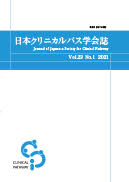Volume 18, Issue 3
Journal of Japanese Society for Clinical Pathway Vol.18 No.3 2016
Displaying 1-13 of 13 articles from this issue
- |<
- <
- 1
- >
- >|
Original Article
-
2016Volume 18Issue 3 Pages 193-198
Published: September 10, 2016
Released on J-STAGE: March 31, 2021
Download PDF (1049K)
Study Report
-
2016Volume 18Issue 3 Pages 201-207
Published: September 10, 2016
Released on J-STAGE: March 31, 2021
Download PDF (1513K)
Practical Report
-
2016Volume 18Issue 3 Pages 211-219
Published: September 10, 2016
Released on J-STAGE: March 31, 2021
Download PDF (892K)
Special Topic(The 16th Annual Congress)
-
2016Volume 18Issue 3 Pages 223-227
Published: September 10, 2016
Released on J-STAGE: March 31, 2021
Download PDF (1890K) -
2016Volume 18Issue 3 Pages 228-232
Published: September 10, 2016
Released on J-STAGE: March 31, 2021
Download PDF (1730K) -
2016Volume 18Issue 3 Pages 233-236
Published: September 10, 2016
Released on J-STAGE: March 31, 2021
Download PDF (1750K) -
2016Volume 18Issue 3 Pages 237-238
Published: September 10, 2016
Released on J-STAGE: March 31, 2021
Download PDF (717K) -
2016Volume 18Issue 3 Pages 239-240
Published: September 10, 2016
Released on J-STAGE: March 31, 2021
Download PDF (815K) -
2016Volume 18Issue 3 Pages 241-248
Published: September 10, 2016
Released on J-STAGE: March 31, 2021
Download PDF (2196K) -
2016Volume 18Issue 3 Pages 249-253
Published: September 10, 2016
Released on J-STAGE: March 31, 2021
Download PDF (1022K) -
2016Volume 18Issue 3 Pages 254-258
Published: September 10, 2016
Released on J-STAGE: March 31, 2021
Download PDF (1722K) -
2016Volume 18Issue 3 Pages 259-262
Published: September 10, 2016
Released on J-STAGE: March 31, 2021
Download PDF (1487K) -
2016Volume 18Issue 3 Pages 263-266
Published: September 10, 2016
Released on J-STAGE: March 31, 2021
Download PDF (1419K)
- |<
- <
- 1
- >
- >|
